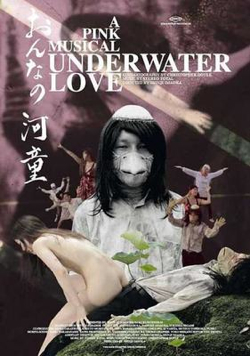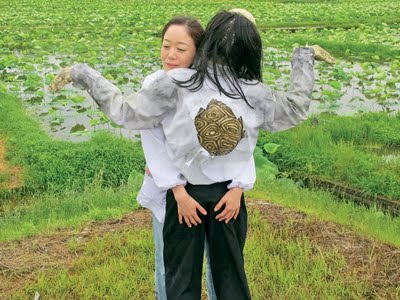AMPHIBIOUS AFFECTIONS
AMPHIBIOUS AFFECTIONS : Screenwriter Tom Mes talks about Shinji Imaoka’s pink musical UNDERWATER LOVE
Interview by Kier-La Janisse
——————
Fans of Asian genre cinema know Tom Mes from his influential Midnight Eye online magazine and his books about Shinya Tsukamoto and Takashi Miike, among numerous other writing and curating cialis generic drug projects. So it didn’t come as much of a surprise when it was announced that he would be penning the script for Uncle’s Paradise director Shinji Imaoka’s new pinku film Underwater Love. But Underwater Love is no ordinary sex film. The requisite sex scenes are there to be sure – and they are as strange as anything in Imaoka’s jaw-dropping catalogue of weirdness – but at its core Underwater Love is also a surprisingly warm and charming film about a woman who rediscovers the joys of youth just as she is on the verge of slipping into complacency through an impending marriage. Using the folkloric kappa – or swamp creature –as a catalyst for and self-examination (the latter made apparent through hilarious musical numbers scored by electro group Stereo Total) and re-addressing grief, Mes and Imaoka – together with renowned cinematographer Christopher Doyle and FX whiz Yoshihiro Nishimura – have concocted a love story that goes to some very unexpected places.
——————
How did you transition from someone who writes about Asian films to be involved with writing a online pharmacies pink film?
The German co-producer of Underwater Love, Rapid Eye Movies, asked me to re-write the script. I’d worked with them on some of their DVD projects, best online generic levitra so we go back quite a few years. A couple of years ago I showed them my script for a film project I was trying get off the ground. That project never saw the light of day, but I guess they liked my writing enough to give me a shot rewriting Underwater Love.
What was your collaboration like with Shinji Imaoka?
I never met him! My only buy levitra online viagra contact was the producer Stephan Holl, who runs Rapid Eye Movies. My impression is that Stephan wanted to present his take on the material to the Japanese, because the rewrites he’d asked them to do weren’t quite to his liking. So I was never in touch directly viagra no prescription with Imaoka or anyone else on the Japanese side. They did later send me the shooting script that Imaoka and his scriptwriter Fumio Moriya wrote based on my draft, and was quite surprised to discover it actually contained fewer sex scenes! I really love the way the film came out, though. I’ve watched it a couple of times now and it really gains dimension with every viewing.
Was a pink musical something you thought might appeal especially to Western audiences?
I can’t claim the credit for the idea, since the genre and format were already part of the package when I came aboard, but it sounded like a shoe-in to me. Having said that, when I was working on my draft I left all the musical scenes as they were, because the music and lyrics had already been written.
 All the pinku films I’ve seen have been very strange, surreal, absurdist and/or psychotronic – I’m just wondering if this is because all the ones i’ve seen have been filtered through Western cult media that picks up on the weird ones, or if pinku films are just weird in general.
All the pinku films I’ve seen have been very strange, surreal, absurdist and/or psychotronic – I’m just wondering if this is because all the ones i’ve seen have been filtered through Western cult media that picks up on the weird ones, or if pinku films are just weird in general.
Depends on your definition of weird, but let’s say that the lion’s share is not much to write home about. Even directors that have made some really weird ones have churned out more than their share of fairly tedious filler. But that’s inevitable in an industrial genre like pinku. It’s like all those straight-to-video yakuza movies that Takashi Miike used to make: they’re very hit and miss, and usually it’s the latter. So there’s definitely a selection at the gate going on for what we get to see in the West.
Beneath all the gaiety in this film, there are a few serious issues – the death by drowning of a teenager , a woman being faced with the past and forced to reconsider her decision to get married. How did you approach the balance between the fun and tragic aspects of the script? At what point was it decided that the kappa myth was going to be the means of exploring these issues?
Since kappa are supposed to be immortal, it gave us a great framework to deal with things like mortality and aging, and the way these affect the way we experience sexuality. The appearance of the kappa puts Asuka in touch with this life force she thought she no longer had and she starts to wonder if maybe life can be more fun than she imagined it for herself. So the fantasy and fun on the one hand and the more serious aspects were very closely connected the whole time. They balanced each other, really. It’s like Cronenberg’s notion of a film’s internal logic. As long as you stay true to that, you’ll keep things in balance.
How well known is the Kappa myth in Japan today?
I doubt there is a single Japanese, old or young, who doesn’t know what a kappa is. They’re still quite popular figures, not only in folk tales, but also in contemporary fiction. There was a kappa in Miike’s Great Yokai War and two, three years ago there was a hit anime that had a kappa as a main character. Both of those films were made for quite young audiences and did good business.
Kappas are known as polite to a fault, but apparently are also notorious ravishers of women – how do these two things reconcile? How much did you try to stick to the mythology in creating the character of Aoki?
The character in the movie actually sticks fairly close to the mythology, aside from Aoki’s more humanized look. But yeah, there is a family-friendly version of the kappa that pops up in kids’ stories – the likeable water sprite who can be a kid’s best friend, almost like E.T. And then there are the kappa for adults, like those in ukiyo-e prints that show them having sex with women and being mischievous in a more lecherous way. Obviously we weren’t making E.T., so we went for the adult version. But his laidback attitude in the movie makes our kappa very likeable as well in the end.
Tell me about the anal pearl and its purpose in Kappa mythology.
That was something that I was actually completely unfamiliar with, but I thought the idea was crazy enough to be fun. It played a larger role in the earlier drafts of the script, including mine, and had a different function too. So it was something that we toyed around with, without worrying about rules or mythology. I had no idea the thing was going to look so huge in the finished film, though!
Is being involved with film production going to be a continued path for you now?
As a film critic you always look at films from the outside and draw your conclusions based on what you see on the screen. I’m curious about what happens along the way that influences what finally winds up on the screen, which is why I’ve always enjoyed visiting film sets. Writing scripts and seeing them through production is a natural progression, in my opinion. At the moment I’m working on a project for a nightmarish thriller in France, to be directed by a Japanese director, and I’ve got a horror film project with a producer in Japan. Both are features based on original scripts of mine. It’s early days yet, but whatever happens, these are going to be worthwhile experiences.
——————
UNDERWATER LOVE has its Canadian Premiere on July 20th at 10pm in the Hall Theatre, and screens again on July 23rd at 11:55pm in the Salle JA DeSeve. More details on the film pager HERE.

 July 20, 2011
July 20, 2011  No Comments
No Comments








